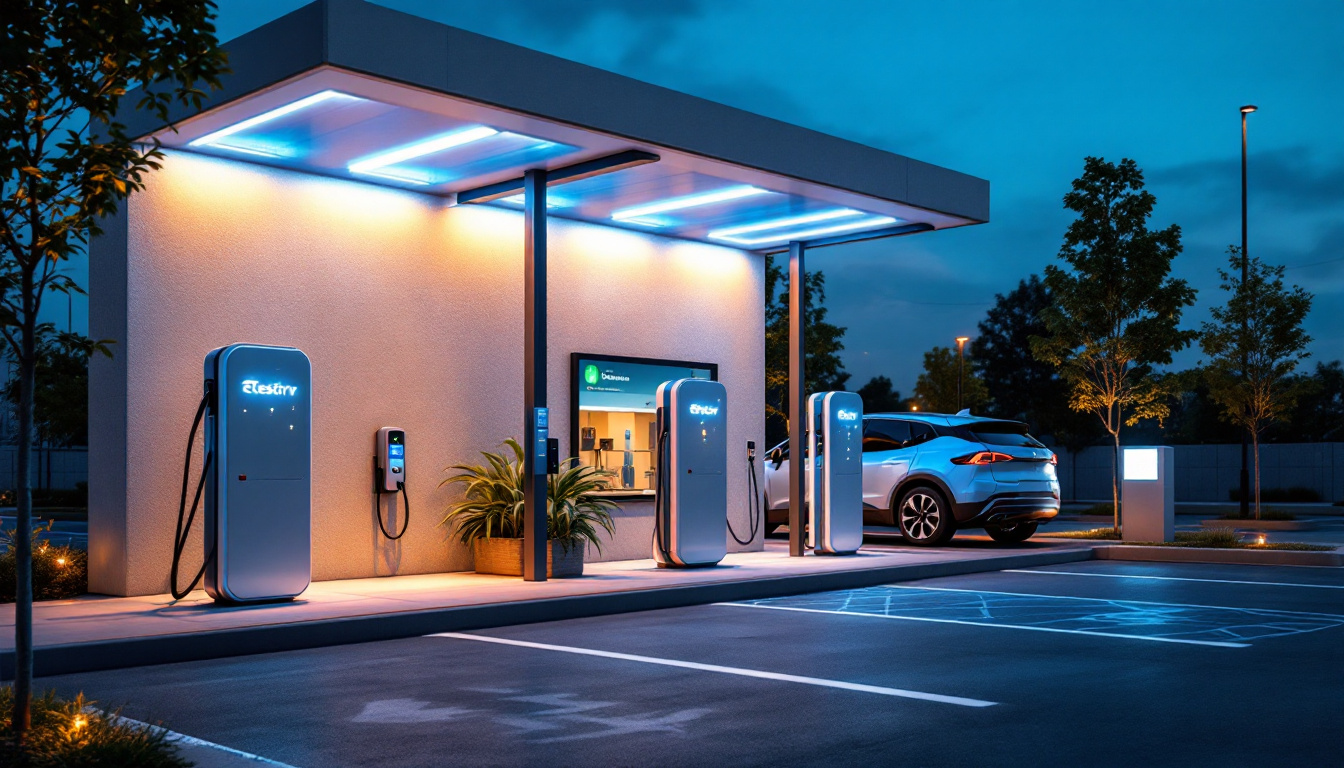
As electric vehicles (EVs) gain traction in the commercial sector, the demand for efficient and effective EV charging solutions is on the rise. For lighting contractors, integrating commercial EV chargers into their projects presents a unique opportunity, but it also comes with its own set of challenges. Understanding how to avoid costly mistakes in lighting projects involving EV chargers is essential for ensuring both client satisfaction and project profitability.
Proper planning is the cornerstone of any successful project, especially when it comes to integrating EV chargers with lighting systems. A well-thought-out plan can help mitigate risks and streamline the installation process. It lays the groundwork for effective communication among stakeholders and ensures that everyone is aligned on the project goals, timelines, and budget constraints. This proactive approach not only enhances efficiency but also fosters a collaborative environment where challenges can be addressed promptly.
Before moving forward with a project, it is crucial to assess the site requirements thoroughly. This includes evaluating the electrical infrastructure, available space, and the specific needs of the client. Understanding the layout of the property and the expected usage of the EV chargers can inform decisions about the placement of both chargers and lighting fixtures. Analyzing traffic patterns and peak usage times can also provide valuable insights into how to optimize the installation for maximum accessibility and convenience.
Additionally, consider the future growth of the site. Will the number of EV chargers need to increase? Will additional lighting be necessary as the property expands? Planning for these possibilities can save time and resources in the long run. It’s also wise to engage with the local community to gauge potential demand for EV charging stations, as this can influence the scale and scope of the project. By anticipating future needs, you can create a more sustainable and adaptable infrastructure that meets the evolving demands of electric vehicle users.
Each jurisdiction has its own set of regulations concerning EV chargers and lighting installations. Familiarizing yourself with these regulations is vital to avoid potential fines and project delays. This may include permits, electrical codes, and safety standards that must be adhered to during the installation process. Engaging with local authorities early in the planning phase can help clarify these requirements and ensure compliance, which is essential for the project’s success.
Staying updated on local policies can also provide insights into incentives or rebates available for EV charger installations, which can be beneficial for both contractors and clients. Many municipalities are actively promoting the adoption of electric vehicles through financial incentives, and understanding these programs can significantly reduce project costs. Furthermore, being aware of any upcoming changes in regulations can help you future-proof your installations, allowing for seamless upgrades and expansions as technology and user needs evolve.
The selection of equipment plays a significant role in the success of lighting projects that incorporate commercial EV chargers. Choosing the right products can enhance efficiency and longevity while minimizing maintenance costs. The right equipment not only ensures optimal performance but also contributes to a seamless user experience, which is paramount in attracting more customers to utilize EV charging stations.
Not all EV chargers are created equal. When selecting chargers, it is essential to evaluate their compatibility with various vehicle models and charging standards. This ensures that the chargers will meet the needs of all potential users, thereby maximizing their utility. In addition to compatibility, it’s also beneficial to consider the charging speed; some chargers offer fast charging capabilities, which can significantly reduce the time drivers spend waiting, thereby enhancing customer satisfaction.
Moreover, consider the power requirements of the chargers. Ensure that the existing electrical infrastructure can support the load without requiring extensive upgrades. This not only keeps costs down but also simplifies the installation process. It may also be wise to look into future-proofing your investment by selecting chargers that can accommodate advancements in EV technology, such as higher voltage systems that may become standard in the coming years.
Proper lighting is critical in EV charging areas for safety and usability. It is essential to choose lighting solutions that provide adequate illumination while being energy-efficient. LED fixtures are often the best choice due to their longevity and low energy consumption. Additionally, the color temperature of the lighting can impact the overall ambiance; cooler temperatures can create a more modern feel, while warmer tones may make the area feel more inviting and comfortable for users waiting to charge their vehicles.
Consider the placement of lighting fixtures to avoid shadows and dark spots that could pose safety risks. Additionally, integrating smart lighting controls can enhance energy efficiency and allow for better management of lighting levels based on usage patterns. Implementing motion sensors can also add an extra layer of efficiency, ensuring that lights are only activated when needed, further reducing energy consumption. Furthermore, incorporating visual elements such as signage illuminated by the lighting can guide users effectively and enhance the overall aesthetic of the charging area, making it not just functional but also visually appealing.
Even with the best planning and equipment selection, mistakes can occur during the installation phase. Adhering to best practices can help minimize errors and ensure a smooth installation process.
It is paramount to involve qualified professionals in the installation of both EV chargers and lighting systems. This includes licensed electricians who are experienced in handling high-voltage equipment and familiar with local codes.
Additionally, consider collaborating with specialists who have expertise in EV charging infrastructure. Their insights can help navigate potential pitfalls and ensure that the installation meets industry standards. Engaging these professionals from the outset can also facilitate better communication among all parties involved, ensuring that everyone is aligned on project goals and timelines. This collaborative approach can significantly reduce the likelihood of miscommunication and errors during the installation process.
Once the installation is complete, conducting thorough testing is essential. This includes checking the functionality of the EV chargers, ensuring that lighting levels meet safety standards, and verifying that all systems operate seamlessly together.
Documenting the testing process can also provide valuable information for future maintenance and troubleshooting, helping to avoid costly mistakes down the line. Furthermore, it is beneficial to implement a regular maintenance schedule post-installation. This proactive approach not only extends the lifespan of the equipment but also ensures that any potential issues are identified and addressed promptly. Regular inspections can help maintain optimal performance and safety, ultimately providing peace of mind for both operators and users of the EV charging stations and lighting systems.
Maintenance is a critical aspect of any lighting project, especially when it involves commercial EV chargers. Regular maintenance can extend the lifespan of both chargers and lighting systems, ensuring ongoing performance and reliability.
Creating a maintenance schedule is vital for keeping both EV chargers and lighting fixtures in optimal condition. This should include routine inspections, cleaning, and any necessary repairs. Regular maintenance can help identify issues before they escalate into costly problems.
Furthermore, educating clients on the importance of maintenance can foster a sense of responsibility and encourage them to adhere to the schedule, ultimately benefiting the longevity of the installation.
Incorporating smart technology into maintenance practices can enhance efficiency and effectiveness. Smart monitoring systems can provide real-time data on the performance of EV chargers and lighting systems, alerting contractors to potential issues before they become significant problems.
These systems can also help track energy consumption, allowing for better management of resources and identification of areas for improvement.
Educating clients about the systems being installed is crucial for ensuring satisfaction and proper usage. Engaged clients are more likely to appreciate the value of the installation and understand the importance of maintenance.
Offering comprehensive training sessions for clients can empower them to use the EV chargers and lighting systems effectively. This training should cover operational procedures, troubleshooting tips, and maintenance best practices.
Additionally, providing user manuals and resources can serve as helpful references for clients, ensuring they have the information they need at their fingertips.
Encouraging feedback from clients post-installation can provide valuable insights into the effectiveness of the project. This feedback can highlight areas for improvement and help identify potential issues that may not have been apparent during the installation process.
Moreover, maintaining an open line of communication can foster a positive relationship between contractors and clients, leading to repeat business and referrals.
Integrating commercial EV chargers into lighting projects presents a unique opportunity for lighting contractors. However, it is essential to approach these projects with careful planning, the right equipment choices, and adherence to best practices to avoid costly mistakes.
By focusing on thorough site assessments, understanding local regulations, selecting compatible equipment, and ensuring proper installation and maintenance, contractors can deliver successful projects that meet client needs and expectations.
Ultimately, education and engagement with clients can enhance satisfaction and foster long-term relationships, paving the way for future opportunities in the growing field of electric vehicle infrastructure.
Ready to elevate your lighting projects with commercial EV chargers? Look no further than LumenWholesale for all your lighting needs. Our extensive selection of spec-grade lighting products is designed to meet the highest industry standards, ensuring your installations are not just successful, but also cost-effective. With unbeatable wholesale prices and the convenience of bulk buying with free shipping, we provide the value and quality you need to avoid costly mistakes and exceed client expectations. Discover wholesale lighting at the best value and make your next project a shining success with LumenWholesale.

Discover the transformation of lighting technology with LED troffer light fixtures.

Discover how lighting contractors can enhance their projects and boost client satisfaction with innovative over bed lighting solutions.

Discover how solar lights are transforming outdoor spaces with real-world success stories from lighting contractors.

Discover essential tips and common pitfalls to avoid when selecting vintage industrial pendant lights for your projects.